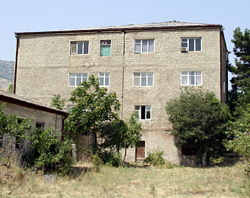Hadrut Province
Hadrut
Հադրութ | |
|---|---|
 | |
| Country | Republic of Artsakh |
| Disestablishment | November 2020 |
| Seat | Hadrut |
| Government | |
| • Governor | Valery Gevorkian (before 2020) |
| Area | |
• Total | 1,877 km2 (725 sq mi) |
| • Rank | Ranked 2nd |
| Population (2013)[1] | |
• Total | 13,163 |
| • Rank | Ranked 5th |
| • Density | 7.0/km2 (18/sq mi) |
| FIPS 10-4 | Azer |
| Website | Hadrut Province |
Hadrut Province (Armenian: Հադրութի շրջան) was a province of the Republic of Artsakh. The provincial capital was Hadrut city. The last governor was Valery Gevorkian. The province was captured by the armed forces of the Republic of Azerbaijan during the 2020 Nagorno-Karabakh war.
It consisted of most of the Jabrayil District, the western part of the Fuzuli District as well as the southwestern part of the Khojavend District.
History
[edit]More than 340 people of Hadrut Region fell victim during the First Nagorno-Karabakh War.[citation needed]
During the 2020 Nagorno-Karabakh conflict, heavy fighting took place in and around the city of Hadrut. Independent sources confirmed that the Azerbaijani army took control of the city of Hadrut on either 14 or 15 October 2020.[2][3] Following the Aras Valley campaign and the Battle of Shusha, all of Hadrut Province was captured by the Azerbaijan Army by 9 November 2020.[4] A peacekeeping contingent of the Russian Federation was placed along the frontline.
Geography
[edit]Hadrut Province formed the breakaway Republic of Artsakh's southern border and is one of its most mountainous parts. Villages were primarily found along two river valleys and scattered in lower elevations on the very southern fringe. Excavations of the Azokh Cave showed that humans have inhabited this area for tens of thousands of years, and the region has a rich history.
Hadrut province had 30 communities of which one was considered urban and 29 were rural. The most important problems were drinking and irrigation water, and internal communication roads. Some villages were lacking a telephone network and some had difficulties with watching Armenian TV channels. Nearly 30% of its area has been ruined and burnt several times.[5]
Settlements
[edit]
|
Sites of interest
[edit]
- Monastery of Spitak Khatch (Սպիտակ Խաչ; White Cross), 14th century
- Gtichavank monastery (Գտիչի վանք), 1241–1248
- Anapat Church (Անապատ եկեղեցի), 13th century, near the village of Togh (Տող)
- Khodaafarin Bridges
See also
[edit]References
[edit]- ^ Census
- ^ "An Execution in Hadrut". Bellingcat. 15 October 2020. Retrieved 2020-10-16.
- ^ "President of Azerbaijan: 'Hadrut settlement and several villages liberated from occupation'". APA.az. 9 October 2020. Archived from the original on 10 October 2020. Retrieved 9 October 2020.
Azerbaijan's Hadrut settlement and several villages were liberated from Armenian aggressors, President Ilham Aliyev said this in his address to the nation, APA reports.
- ^ "İşğaldan azad olunan şəhər, qəsəbə və kəndlərimiz".
- ^ Hetq.am Now the time has come for building Archived 2011-05-31 at the Wayback Machine

